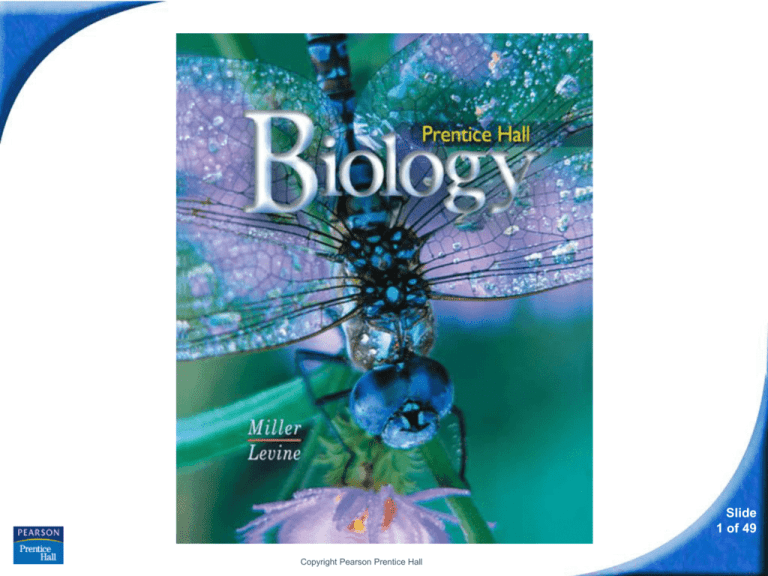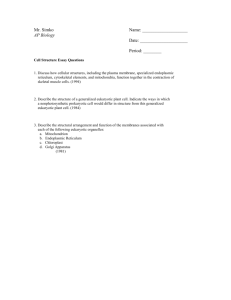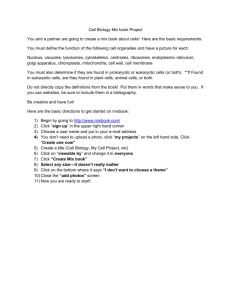
Biology
Biology
Slide
1 of 49
Copyright Pearson Prentice Hall
7-2 Eukaryotic Cell Structure
Slide
2 of 49
Copyright Pearson Prentice Hall
7-2 Eukaryotic Cell Structure
Comparing the Cell to a Factory
Plant Cell
Nucleolus
Nucleus
Smooth
endoplasmic
reticulum
Nuclear envelope
Ribosome (free)
Rough endoplasmic
reticulum
Ribosome
(attached)
Golgi
apparatus
Cell wall
Cell membrane
Chloroplast
Mitochondrion
Vacuole
Slide
3 of 49
Copyright Pearson Prentice Hall
7-2 Eukaryotic Cell Structure
Comparing the Cell to a Factory
Animal Cell
Nucleolus
Smooth endoplasmic
reticulum
Nucleus
Ribosome (free)
Nuclear envelope
Cell membrane
Rough
endoplasmic
reticulum
Ribosome
(attached)
Centrioles
Golgi
apparatus
Mitochondrion
Slide
4 of 49
Copyright Pearson Prentice Hall
7-2 Eukaryotic Cell Structure
Comparing the Cell to a Factory
Eukaryotic Cell Structures
Structures within a eukaryotic cell that perform
important cellular functions are known as
organelles…
Play on the word…“organs of the cell”
Slide
5 of 49
Copyright Pearson Prentice Hall
7-2 Eukaryotic Cell Structure
The cytoplasm is the
“fluid” portion of the cell
outside the nucleus.
Its function is to:
--“hold” other
organelles; interior
space, place to make
exchanges w/ other
parts
Analogous to the
area/space inside a
Copyright Pearson Prentice Hall
Slide
6 of 49
7-2 Eukaryotic Cell Structure
Nucleus
What is the function of the nucleus?
Slide
7 of 49
Copyright Pearson Prentice Hall
7-2 Eukaryotic Cell Structure
Nucleus
Nucleus
The nucleus contains nearly all the cell's
DNA (genetic information) and with it
the coded instructions for making
proteins and other important molecules.
The nucleus is the control center of the cell.
Analogous to the manager or boss of the
factory.
Slide
8 of 49
Copyright Pearson Prentice Hall
7-2 Eukaryotic Cell Structure
Nucleus
The Nucleus
Chromatin
Nuclear envelope
Nucleolus
Nuclear
pores
Slide
9 of 49
Copyright Pearson Prentice Hall
7-2 Eukaryotic Cell Structure
Nucleus
The nucleus is
surrounded by a
nuclear envelope
composed of two
membranes.
The envelope is
dotted with nuclear
pores, which allow
material to move in
and out of the
nucleus.
Nuclear
envelope
Nuclear
pores
Analogy: mgr office
Copyright Pearson Prentice Hall
Slide
10 of 49
7-2 Eukaryotic Cell Structure
Nucleus
The granular material in the nucleus is called
chromatin.
Chromatin consists of DNA bound to protein.
Chromatin
Slide
11 of 49
Copyright Pearson Prentice Hall
7-2 Eukaryotic Cell Structure
Nucleus
When a cell divides, chromatin condenses to form
chromosomes.
Chromosomes contain the genetic information that is
passed from one generation of cells to the next.
How does the manager know what to do?
Slide
12 of 49
Copyright Pearson Prentice Hall
7-2 Eukaryotic Cell Structure
Nucleolus: found inside the nucleus itself.
Made of RNA; Its job is to make ribosomes
Ribosomes are the workers of the cell.
They make the proteins.
Analogous to: make the tools
Used in the factory. What
Makes the robots that put
Slide
13 of 49
Cars together?
Copyright Pearson Prentice Hall
7-2 Eukaryotic Cell Structure
Nucleus
Most nuclei also contain a nucleolus.
The nucleolus is where the assembly of ribosomes
begins.
Nucleolus
Slide
14 of 49
Copyright Pearson Prentice Hall
7-2 Eukaryotic Cell Structure
Ribosomes
What is the function of the ribosomes?
Slide
15 of 49
Copyright Pearson Prentice Hall
7-2 Eukaryotic Cell Structure
Ribosomes
Ribosomes
One of the most important jobs carried out in
the cell is making proteins.
Proteins are assembled on ribosomes.
Ribosomes are small particles of RNA and
protein found throughout the cytoplasm and
attached to other organelles.
Slide
16 of 49
Copyright Pearson Prentice Hall
7-2 Eukaryotic Cell Structure
Ribosomes
Ribosomes produce proteins by following coded
instructions that come from the nucleus.
Cells that are active in protein synthesis are often
packed with ribosomes.
Extremely small…you won’t see them with our
microscopes.
Slide
17 of 49
Copyright Pearson Prentice Hall
7-2 Eukaryotic Cell Structure
Endoplasmic Reticulum
What is the function of the endoplasmic
reticulum?
Slide
18 of 49
Copyright Pearson Prentice Hall
7-2 Eukaryotic Cell Structure
Endoplasmic Reticulum
Endoplasmic Reticulum
Eukaryotic cells contain an internal membrane
system called the endoplasmic reticulum, or
ER.
The endoplasmic reticulum is where:
1. proteins are shaped (folded) and modified
and moved within the cell to begin the
“export” process.
Slide
19 of 49
Copyright Pearson Prentice Hall
7-2 Eukaryotic Cell Structure
Endoplasmic Reticulum
Endoplasmic
Reticulum
Ribosomes
Slide
20 of 49
Copyright Pearson Prentice Hall
7-2 Eukaryotic Cell Structure
Endoplasmic Reticulum
There are two types of ER—rough and smooth.
1. The portion of the ER involved in protein
modification is called rough endoplasmic reticulum, or
rough ER.
Ribosomes are found on the surface of rough ER.
Rough ER is abundant in cells that produce large
amounts of protein for export.
Slide
21 of 49
Copyright Pearson Prentice Hall
7-2 Eukaryotic Cell Structure
Endoplasmic Reticulum
2. Smooth ER does not have ribosomes on its
surface.
Smooth ER contains collections of enzymes that
perform specialized tasks, such as:
1. making lipid parts of the cell membrane are
assembled
2. synthesis of membrane lipids and
detoxification of drugs.
Slide
22 of 49
Copyright Pearson Prentice Hall
7-2 Eukaryotic Cell Structure
Golgi Apparatus
What is the function of the Golgi
apparatus?
Slide
23 of 49
Copyright Pearson Prentice Hall
7-2 Eukaryotic Cell Structure
Golgi Apparatus
Golgi Apparatus
Proteins produced/modified in the rough ER move
into the Golgi apparatus.
to be “packaged” within a vesicle (a
membrane bound container) and exported.
Slide
24 of 49
Copyright Pearson Prentice Hall
7-2 Eukaryotic Cell Structure
Golgi Apparatus
The Golgi apparatus appears as a stack of closely
apposed membranes.
Slide
25 of 49
Copyright Pearson Prentice Hall
7-2 Eukaryotic Cell Structure
Golgi Apparatus
The Golgi apparatus modifies, sorts, and
packages proteins and other materials from the
endoplasmic reticulum for storage in the cell or
secretion outside the cell.
From the Golgi apparatus, proteins are then
“shipped” to their final destinations
throughout the cell or outside of the cell.
Slide
26 of 49
Copyright Pearson Prentice Hall
7-2 Eukaryotic Cell Structure
Lysosomes
What is the function of lysosomes?
Slide
27 of 49
Copyright Pearson Prentice Hall
7-2 Eukaryotic Cell Structure
Lysosomes
Lysosomes
Lysosomes are small organelles filled with
enzymes.
Lysosomes break down lipids, carbohydrates, and
proteins into small molecules that can be used by
the rest of the cell.
Lysosomes also break down organelles that have
outlived their usefulness.
Analogous to ????
Slide
28 of 49
Copyright Pearson Prentice Hall
7-2 Eukaryotic Cell Structure
Lysosome
Slide
29 of 49
Copyright Pearson Prentice Hall
7-2 Eukaryotic Cell Structure
Slide
30 of 49
Copyright Pearson Prentice Hall
7-2 Eukaryotic Cell Structure
Vacuoles
What is the function of vacuoles?
Slide
31 of 49
Copyright Pearson Prentice Hall
7-2 Eukaryotic Cell Structure
Vacuoles
Vacuoles
Some cells contain saclike structures called
vacuoles that store materials such as water, salts,
proteins, and carbohydrates.
Analogous to: supply room or storage warehouse?
Slide
32 of 49
Copyright Pearson Prentice Hall
7-2 Eukaryotic Cell Structure
Vacuoles
In many plant cells there
is a single, large central
vacuole filled with liquid.
The pressure of the
central vacuole allows
plants to support heavy
structures such as leaves
and flowers.
Vacuole
Slide
33 of 49
Copyright Pearson Prentice Hall
7-2 Eukaryotic Cell Structure
Vacuoles are also found
in some unicellular
organisms and in some
animals.
Vacuoles
Contractile vacuole
The paramecium contains
a contractile vacuole that
pumps excess water out
of the cell.
Slide
34 of 49
Copyright Pearson Prentice Hall
7-2 Eukaryotic Cell Structure
Mitochondria and Chloroplasts
What is the function of the mitochondria?
Slide
35 of 49
Copyright Pearson Prentice Hall
7-2 Eukaryotic Cell Structure
Mitochondria and Chloroplasts
Mitochondria
Nearly all eukaryotic
cells contain
mitochondria.
Mitochondria convert
the chemical energy
stored in food into
compounds that are
more convenient for
the cell to use: cell
respiration.
Analogous to Power
plant? Electrical
panel?
Copyright Pearson Prentice Hall
Mitochondrion
Slide
36 of 49
7-2 Eukaryotic Cell Structure
Mitochondria and Chloroplasts
What is the function of chloroplasts?
Slide
37 of 49
Copyright Pearson Prentice Hall
7-2 Eukaryotic Cell Structure
Chloroplasts
Mitochondria and Chloroplasts
Chloroplast
Plants and some other organisms
contain chloroplasts.
Chloroplasts capture
energy from sunlight and
convert it into chemical
energy in a process
called photosynthesis.
Make sugar (food)
Analogous to: factory
cafeteria or break room
Slide
38 of 49
Copyright Pearson Prentice Hall
7-2 Eukaryotic Cell Structure
Mitochondria and Chloroplasts
Chloroplasts contain the green pigment chlorophyll.
Chlorophyll is an enzyme that plants use to convert
sun light energy into chemical energy (sugars)
Slide
39 of 49
Copyright Pearson Prentice Hall
7-2 Eukaryotic Cell Structure
Cytoskeleton
What are the functions of the
cytoskeleton?
Slide
40 of 49
Copyright Pearson Prentice Hall
7-2 Eukaryotic Cell Structure
Cytoskeleton
Cytoskeleton
Eukaryotic cells are given their shape and internal
organization by the cytoskeleton.
Slide
41 of 49
Copyright Pearson Prentice Hall
7-2 Eukaryotic Cell Structure
Cytoskeleton
The cytoskeleton is a network of protein
filaments that helps the cell to maintain
its shape. The cytoskeleton is also
involved in movement within the cell.
The cytoskeleton is made up of:
• microfilaments
• microtubules
• Analogous to: internal walls/ 2 x4s, etc
Slide
42 of 49
Copyright Pearson Prentice Hall
7-2 Eukaryotic Cell Structure
Cytoskeleton
Cytoskeleton
Cell membrane
Endoplasmic
reticulum
Microtubule
Microfilament
Ribosomes
Mitochondrion
Copyright Pearson Prentice Hall
Slide
43 of 49
7-2 Eukaryotic Cell Structure
Cytoskeleton
In animal cells, structures known as Centrioles are
located near the nucleus and help to organize
chromosomes during cell division.
Look like “stars”. Each cell has two centrioles.
Analogous to: manager’s assistant who helps
organize his office?
Slide
44 of 49
Copyright Pearson Prentice Hall
7-2 Eukaryotic Cell Structure
Cell wall: extra layer around PLANT cells for
protection and shape. Does not control what goes
in/out of a cell.
Analogous to: factory fence?
Slide
45 of 49
Copyright Pearson Prentice Hall
7-2 Eukaryotic Cell Structure
Cell membrane: outer layer of all cells. Controls what
goes in/out of cell.
Analogous to: security guards?
Slide
46 of 49
Copyright Pearson Prentice Hall
7-2
Click to Launch:
Continue to:
- or -
Slide
47 of 49
Copyright Pearson Prentice Hall
7-2
In the nucleus of a cell, the DNA is usually visible
as
a. a dense region called the nucleolus.
b. the nuclear envelope.
c. granular material called chromatin.
d. condensed bodies called chloroplasts.
Slide
48 of 49
Copyright Pearson Prentice Hall
7-2
Two functions of vacuoles are storing materials
and helping to
a. break down organelles.
b. assemble proteins.
c. maintain homeostasis.
d. make new organelles.
Slide
49 of 49
Copyright Pearson Prentice Hall
7-2
Chloroplasts are found in the cells of
a. plants only.
b. plants and some other organisms.
c. all eukaryotes.
d. most prokaryotes.
Slide
50 of 49
Copyright Pearson Prentice Hall
7-2
Which of the following is NOT a function of the
Golgi apparatus?
a. synthesize proteins
b. modify proteins
c. sort proteins
d. package proteins
Slide
51 of 49
Copyright Pearson Prentice Hall
7-2
Which of the following is a function of the
cytoskeleton?
a. manufactures new cell organelles
b. assists in movement of some cells from one
place to another
c. releases energy in cells
d. modifies, sorts, and packages proteins
Slide
52 of 49
Copyright Pearson Prentice Hall
END OF SECTION








